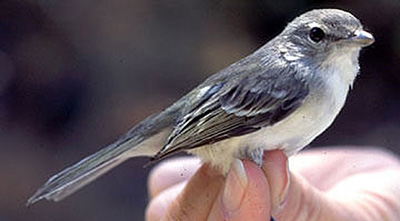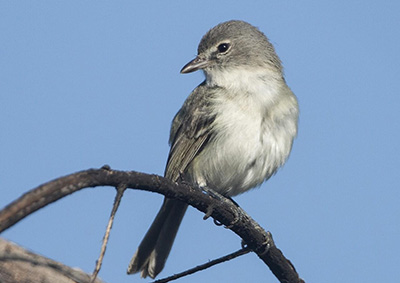Researchers Aim to Understand Threats to Endangered Least Bell's Vireo
 The Least Bell's Vireo (LBVI, Vireo bellii pusillus), which has received federal protection under the Endangered Species Act (ESA) since it was listed as federally endangered in 1986, nests in narrow riparian areas surrounded by the heavily urbanized matrix of Southern California. Stressors - from nest parasitism by brown-headed cowbirds to habitat degradation via drought to invasion of exotic plants and insects - threaten this species and despite the accumulation of data, much is yet to be understood to address the challenges of developing management strategies for recovery and removal from federal ESA protection.
The Least Bell's Vireo (LBVI, Vireo bellii pusillus), which has received federal protection under the Endangered Species Act (ESA) since it was listed as federally endangered in 1986, nests in narrow riparian areas surrounded by the heavily urbanized matrix of Southern California. Stressors - from nest parasitism by brown-headed cowbirds to habitat degradation via drought to invasion of exotic plants and insects - threaten this species and despite the accumulation of data, much is yet to be understood to address the challenges of developing management strategies for recovery and removal from federal ESA protection.
Pat Zollner, professor of wildlife science in the Purdue Department of Forestry and Natural Resources, is the principal investigator on a research project looking at “Alternative Management Strategies to Address Multiple Interacting Stressors on Least Bell Vireo Populations,” thanks to $1.6 million in funding from the U.S. Army Engineer Research and Development Center (ERDC). This project is part of a larger grant of $2.6 million from the Strategic Environmental Research and Development Program (SERDP) to Dr. Rich Fischer of ERDC.
 The U.S. Army Corps of Engineers and U.S. Department of Defense are heavily invested in species protection and recovery due to the fact that several of the largest remaining patches of LBVI nesting habitat occur on military installations and in the USACE’s flood control basins.
The U.S. Army Corps of Engineers and U.S. Department of Defense are heavily invested in species protection and recovery due to the fact that several of the largest remaining patches of LBVI nesting habitat occur on military installations and in the USACE’s flood control basins.
Least Bell's Vireos are among the most costly endangered species to the DOD with expenditures exceeding $2 million annually. Cost-effective strategies for managing interacting stressors to the species are needed to achieve species recovery and sustain populations.
“This project is tailor-made for being addressed through the use of individual/agent-based modeling,” Zollner said. “It is a very complex system where a lot of data has been collected about patterns, but synthesis of all of that information to understand the implications of different scenarios for outcomes for this species of concern are unclear. The model we develop for this research will integrate insights from a suite of sub-models each focused on individual stressors (e.g. invasive plants, invasive insects, hydrology changing due to climate change, etc.) to help us understand the mechanisms underlying the behavior of this system and ultimately identify pathways for recovering this endangered species.”
Zollner, a specialist in developing models which identify the implications of interactions of behavioral and landscape ecology, will be joined in the research by Dakotah Shaffer, a PhD student in Zollner’s lab, and a yet-to-be hired postdoctoral researcher. Dr. Jeffrey Holland, a specialist in beetle spatial ecology, and PhD student Rennie McIntosh from the Purdue Department of Entomology will provide expertise on the invasive beetle populations that threaten vegetation patches that provide LBVI habitat. This research project will be conducted in conjunction with the US Army ERDC, Conservation Science and Data Visualization LLC, and Rohde Environmental Consulting, LLC.
Researchers are developing an agent-based model (ABM) called RESET (Recovering Endangered Species with Emerging Threats) to understand the effects of individual stressors as well as interacting threats and stressors on the species populations. Through the modeling, they will be able to develop and recommend management strategies to address multiple threats and stressors by changing conditions across replicated models.
with Emerging Threats) to understand the effects of individual stressors as well as interacting threats and stressors on the species populations. Through the modeling, they will be able to develop and recommend management strategies to address multiple threats and stressors by changing conditions across replicated models.
Researchers will take into account stressors related to groundwater extraction, loss of streamflow inputs due to water recycling programs, changing flood and fire regimes, nest parasitism by brown-headed cowbirds, and negative impacts on riparian vegetation by invasive, non-native plants and insects. In doing so, they look to see how each stressor as well as combinations of various stressors may impact the distribution and quality of nesting habitat as well as reproductive performance and metapopulation dynamics.
The model will allow researchers to create simulations based on current conditions as well as with added assistance from alternative management methods to see which actions improve nesting conditions, alleviate key threats and provide the least costly path to recovery. Researchers will work with local and regional stakeholders to develop simulation experiments that explore management alternatives available to each of the major federal action agencies in southern California as well as explore collaborative strategies between federal, state and local management authorities.
Results from the analysis will be used to create a conservation plan for the USACE, including the development of a framework to develop regional or watershed-based conservation plans for long-term management purposes. Results also could be used to inform U.S. Fish and Wildlife Service guidance for recovery such as the development of a cost-effective range-wide cowbird management plan or regional strategies for invasive exotic plant removal.
Work began on the least bell's vireo project in the fall of 2022 and will continue through fall 2026.






